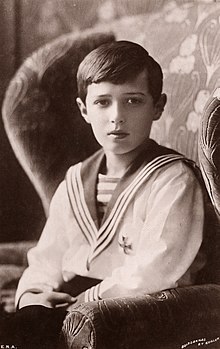
Back Aleksei Nikolajewitsj, tsarewitsj van Rusland Afrikaans ألكسي رومانوف Arabic الكسى رومانوف ARZ Aleksey Nikolayeviç Romanov Azerbaijani Аляксей Мікалаевіч Byelorussian Алексей Николаевич Bulgarian Aleksei Romànov (tsarévitx de Rússia) Catalan Alexej Nikolajevič Czech Aleksej Nikolajevitj af Rusland Danish Alexei Nikolajewitsch Romanow German
| Alexei Nikolaevich | |||||
|---|---|---|---|---|---|
| Tsesarevich of Russia | |||||
 Alexei in 1913 | |||||
| Born | 12 August 1904 [O.S 30 July] Peterhof Palace, St. Petersburg Governorate, Russian Empire | ||||
| Died | 17 July 1918 (aged 13) Ipatiev House, Yekaterinburg, Russian Soviet Republic | ||||
| Cause of death | Execution by firing squad | ||||
| |||||
| House | Holstein-Gottorp-Romanov | ||||
| Father | Nicholas II of Russia | ||||
| Mother | Alix of Hesse and by Rhine | ||||
| Religion | Russian Orthodox | ||||
| Signature |  | ||||
Alexei Nikolaevich (Russian: Алексе́й Никола́евич) (12 August [O.S. 30 July] 1904 – 17 July 1918) was the last Tsesarevich (heir apparent to the throne of the Russian Empire).[note 1] He was the youngest child and only son of Emperor Nicholas II and Empress Alexandra Feodorovna. He was born with haemophilia, which his parents tried treating with the methods of peasant faith healer Grigori Rasputin.[3]
After the February Revolution of 1917, the Romanovs were sent into internal exile in Tobolsk, Siberia. After the October Revolution, the family was initially to be tried in a court of law, before the intensification of the Russian Civil War made execution increasingly favorable in the eyes of the Soviet government. With White Army soldiers rapidly approaching, the Ural Regional Soviet ordered the murder of Alexei, the rest of his family, and four remaining retainers on 17 July 1918. Rumors persisted for decades that Alexei had escaped his execution, with multiple impostors claiming his identity. Alexei's remains, along with those of his sister Maria (or Anastasia), were ultimately discovered in a secondary grave near the rest of the Romanov family in 2007. On 17 July 1998, the 80th anniversary of their execution, Alexei's parents, three of his sisters, and the four retainers, were formally interred in the Cathedral of St. Peter and Paul, while Alexei's and Maria's (or Anastasia's) bones remain in Russian state archives. The Romanov family was canonized as passion bearers by the Russian Orthodox Church in 2000.
Alexei is sometimes known to Russian legitimists as Alexei II after his ancestor Alexis of Russia, as until his death they do not recognize the abdication of his father in favor of his uncle Grand Duke Michael as lawful.[4]
- ^ Macedonsky, Dimitry (2005–2006). "Hail, Son of Caesar! A Titular History of Romanov Scions". European Royal History Journal. 8.3 (XLV): 19–27.
- ^ Burke's Royal Families of the World II. Burke's Peerage Ltd. 1980. p. 65. ISBN 978-0-85011-029-6.
- ^ "Alexis". Encloypaedia Britannica. Retrieved 22 April 2019.
- ^ "The Abdication of Nicholas II: 100 Years Later". The Russian Legitimist. Archived from the original on 31 January 2018. Retrieved 30 January 2018.
Cite error: There are <ref group=note> tags on this page, but the references will not show without a {{reflist|group=note}} template (see the help page).
© MMXXIII Rich X Search. We shall prevail. All rights reserved. Rich X Search